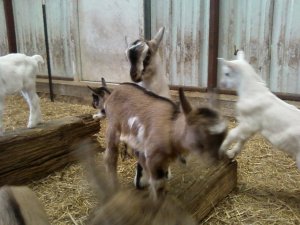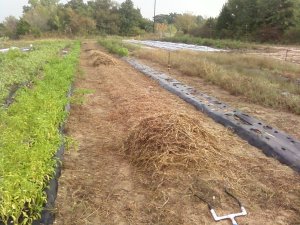My brother hates them, but I love them. They are very interesting and usually misunderstood little things. I remember my first experience beekeeping down here was at Rose Creek Farm, when the farmer there told me about the hive he had in the barn loft, and that “them bees won’t sting you if you get into their honey.” I think this is only partially true. I definitely got stung when I took the lid off, but only a few times (which I attribute to the speed at which I ran across the hay loft and jumped out of the barn like a little girl). But another time, I was sorting out some honey and honeycomb, and by the end of it I had bees up to my elbows on my arms, just trying to get to the honey. In that case we were just people and bugs, trying to get some honey; no stings necessary. The thing to remember is that they won’t bother you unless you start messing with their home.
We work with a beekeeper here who is able to give us lots of help and share his knowledge about everything. In what is one of my favorite jobs here, we have been able to extract hives from hollow tree trunks, travel trailers, old barns, and well-houses. The idea is to get the bees from their old home to their new home (your hive box) with minimal loss and maximum retention of their honey stores, brood and comb. The way we have found to work best is to wire a frame on one side, cut out the comb and lay it onto the frame, and wire the other side so the bee’s old comb is wired vertically in a frame, which you then put in the hive box.
Sometimes the bees are friendly and sometimes they are not. It depends very much on the personality of the hive, the weather, the time of year, and what you do. Some hives we have captured, I didn’t even use a bee suit for part of the time; but some hives were so upset they managed to get INSIDE Rocky and I’s bee suits. That is not very pleasant since your choices are either one bee on the inside, or take of your suit and have all the bees on the inside.
The hardest part so far has been finding the queen in the hive, because without her, the bees will not stay in the box. I’ll explain about that a little later. Occasionally, usually in the Spring or Summer, a hive of bees will swarm, which means a split in the hive due to a lack of room. The existing queen will take half the bees and zoom over to some tree or something and wait while their scouts find a suitable location for a new hive. Meanwhile, the old hive will raise a new queen in place of the one that left, and go on just like before.
So there it is. A swarm of bees on one of our very own peach trees. Was it from one of our hives? Who knows. Today was so warm (85) that it probably inspired the little guys to make a break a for it. You have an undetermined amount of time to catch them, it could be minutes or hours – never more than a day – so I rushed inside to get a hive box and my suit and managed to catch them before they flew away. Basically what happened between these two pictures is that I picked up the swarm and put it in the box; very, very uncomplicated. Sometimes it helps to spray them with sugar water, which discourages flying.
The important thing to make sure of is that the queen is in the hive. It helps to know a few things. First, whenever you see that mob of bees, the queen is consistently working her way towards the center, so if you have to guess, that’s where she’ll be. Secondly, once the swarm is disturbed (and this applies to removing an old hive from something like a tree) most of the bee’s #1 priority will be to find the queen. To help them, bees that know where she is will stand facing her and fan her aroma out, making her presence known. It looks like this, and it is a thing that makes a beekeeper very happy to see.
It kinda looks like they’re doing little handstands. It’s surprising how strong the smell and breeze is from their little wings. you can smell it fairly easily if you’re close. So that means I got ’em, and now the hope is that they will love the hive so much they will never want to leave. Another useful thing to know is that bees will always prefer to walk rather than fly to their destination, presuming it’s fairly close. So in this case I allowed a bridge between the tree and the hive so the rest of them could walk down.
So there you have it. One new hive of bees, $100 just sitting on a branch. Good times with the bees.






















